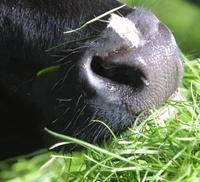Grazing US cattle year-round pays off

The good ol’ days are coming back to the Northern Plains, USA with new twists based on recent research findings by Agricultural Research Service (ARS) scientists.
ARS researchers in Mandan, N.D., have shown that a newly designed program of
“swath grazing” allows cattle to, once again, graze year-round, even in the
middle of a North Dakota winter. The concept involves pushing harvested crop
leftovers into row piles up to 16 inches high, to keep them within reach of cows
in winter.
Winter grazing, from mid-November through mid-March in North
Dakota, can save farmers as much as 24 cents per cow per day, compared to the
costs of baling hay for winter corral feeding. With a herd of 200 cows, that
would save a farmer more than $4,000 in feed costs a year.
Soil scientist
Don Tanaka and colleagues at the ARS Northern Great Plains Research Laboratory
in Mandan calculated those savings based on data from a four-year research
project. In each year of the study, the scientists monitored 20 pregnant
Hereford beef cows due to give birth in March. The nutritional needs of pregnant
cows increases as pregnancy advances. This makes the winter feeding of
late-pregnant cows one of the most expensive times in beef cattle
production.
The researchers compared weight gains from swath-grazing cows
on the residue of annual crops–oats/peas, triticale/sweet clover and corn–to
gains with perennial western wheatgrass, and with bales of hay fed in winter
corrals. Another benefit of swath grazing: The cows in this system also
distributed their manure evenly over the landscape, eliminating the chore of
removing manure from corrals. The manure also provides fertilizer for crops and
improves the soil. Integrating crops and livestock benefits both
enterprises.
Read more about the research in
the July 2008 issue of Agricultural Research magazine.











